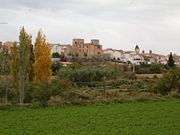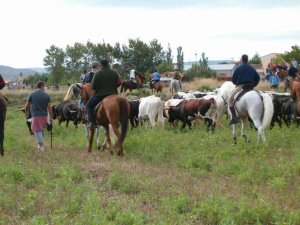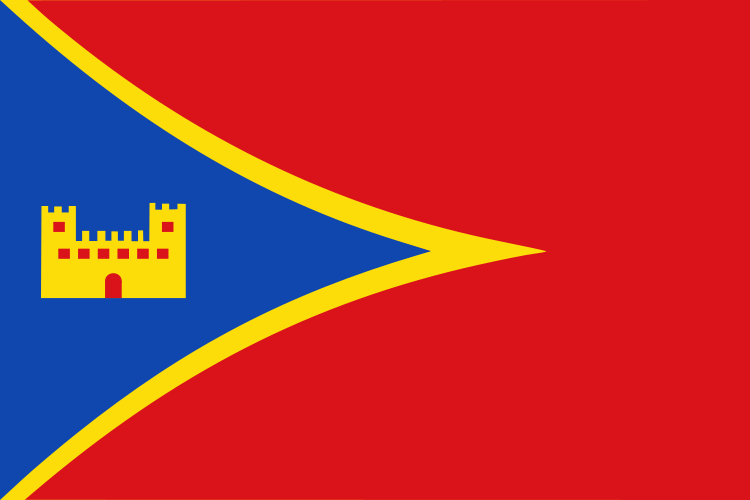
Novallas
Encyclopedia


Zaragoza (province)
Zaragoza is a province of northern Spain, in the central part of the autonomous community of Aragon.Its capital is Zaragoza, which is also the capital of the autonomous community. Other towns in Zaragoza include Calatayud, Borja, La Almunia de Doña Godina, Ejea de los Caballeros and Tarazona.Its...
, Aragon
Aragon
Aragon is a modern autonomous community in Spain, coextensive with the medieval Kingdom of Aragon. Located in northeastern Spain, the Aragonese autonomous community comprises three provinces : Huesca, Zaragoza, and Teruel. Its capital is Zaragoza...
, Spain
Spain
Spain , officially the Kingdom of Spain languages]] under the European Charter for Regional or Minority Languages. In each of these, Spain's official name is as follows:;;;;;;), is a country and member state of the European Union located in southwestern Europe on the Iberian Peninsula...
. It belongs to the "comarca" (county) of Tarazona y el Moncayo
Tarazona y el Moncayo
Tarazona y el Moncayo is a comarca in Aragon, Spain. The most important town is Tarazona.This comarca is located at the western end of Aragon, bordering Navarre, Soria Province and La Rioja...
. According to the 2004 census
Census
A census is the procedure of systematically acquiring and recording information about the members of a given population. It is a regularly occurring and official count of a particular population. The term is used mostly in connection with national population and housing censuses; other common...
(INE
Instituto Nacional de Estadística (Spain)
The National Institute of Statistics is the official organisation in Spain that collects statistics about demography, economy, and Spanish society. Every 10 years, this organisation conducts a national census. The last census took place in 2001....
), the municipality has a population of 807 inhabitants.
Geography
Location: Situated on the left bank of QueilesQueiles
The Queiles is an effluent of the Ebro. Its arises in Vozmediano . It flows through Tarazona and empties into the Ebro near Tudela, Navarre....
to NO of Zaragoza, neighbouring Navarra. Its relief is fairly flat with some inclination to the west of its territory. It is about 100 km far from Soria
Soria
Soria is a city in north-central Spain, the capital of the province of Soria in the autonomous community of Castile and León. , the municipality has a population of c. 39,500 inhabitants, nearly 40% of the population of the province...
, Pamplona
Pamplona
Pamplona is the historial capital city of Navarre, in Spain, and of the former kingdom of Navarre.The city is famous worldwide for the San Fermín festival, from July 6 to 14, in which the running of the bulls is one of the main attractions...
, Logroño
Logroño
Logroño is a city in northern Spain, on the Ebro River. It is the capital of the autonomous community of La Rioja, formerly known as La Rioja Province.The population of Logroño in 2008 was 153,736 and a metropolitan population of nearly 197,000 inhabitants...
and Zaragoza
Zaragoza
Zaragoza , also called Saragossa in English, is the capital city of the Zaragoza Province and of the autonomous community of Aragon, Spain...
, 15 km from Tudela
Tudela, Navarre
Tudela is a municipality in Spain, the second city of the autonomous community of Navarre. Its population is around 35,000. Tudela is sited in the Ebro valley. Fast trains running on two-track electrified railways serve the city and two freeways join close to it...
and 6 km from Tarazona
Tarazona
Tarazona is a municipality in the Spanish province of Zaragoza, in the autonomous community of Aragon. It is the seat of the Roman Catholic Diocese of Tarazona and the capital of the Tarazona y el Moncayo Aragonese comarca.- History :...
. Moncayo
Moncayo
Moncayo may refer to:*Moncayo, a mountain massif of the Sistema Ibérico*Monkayo, Compostela Valley, a municipality in the Philippines-People:*Oswaldo Moncayo, a painter from Ecuador*José Pablo Moncayo, a Mexican composer*Pedro Moncayo, a canton in Ecuador...
mountain is 15 km to the south.
Routes of access: Road N-121 Tarazona
Tarazona
Tarazona is a municipality in the Spanish province of Zaragoza, in the autonomous community of Aragon. It is the seat of the Roman Catholic Diocese of Tarazona and the capital of the Tarazona y el Moncayo Aragonese comarca.- History :...
- Tudela
Tudela, Navarre
Tudela is a municipality in Spain, the second city of the autonomous community of Navarre. Its population is around 35,000. Tudela is sited in the Ebro valley. Fast trains running on two-track electrified railways serve the city and two freeways join close to it...
.
Climate: Continental Mediterranean.
Population
Historical evolution of the Town:1495: 8 Christian fires and 23 Moorish.
1543: 31 fires.
1610: 80 houses
1646: 36 fires.
1713: 27 neighbours.
1722: 18 neighbours.
1787: 18 neighbours.
1797: 58 neighbours.
1857: 1,077 inhabitants.
1877: 1,216 inhabitants.
1900: 1,504 inhabitants.
1910: 1,503 inhabitants.
1920: 1,586 inhabitants.
1930: 1,591 inhabitants.
1940: 1,535 inhabitants.
1950: 1,686 inhabitants.
1960: 1,368 inhabitants.
1965: 1,264 inhabitants.
1970: 1,138 inhabitants.
1980: 936 inhabitants.
1991: 783 inhabitants.
1996: 773 inhabitants.
2000: 731 inhabitants.
2003: 815 inhabitants.
2006: 818 inhabitants.
2007: 875 inhabitants.
In recent years, it has stopped the trend of depopulation that had begun in the 60's. This has been due to immigration, especially Romanians and Equatorians, and the big price of housing in nearby places like Tarazona, that makes people to live in Novallas, with lower prices.
----
Economy
The main economic activity is agriculture, but gradually this activity has become less important compared with building, industry and services. The land is broken into a smallholding. It belongs to people who have received as inheritance and who are not farmers or are already retired. There are few young farmers. Almost all the land of the town is irrigated. The irrigation in areas near the river Queiles is more intensive. The main crops are olives, almonds, and cereal. Most of the orchards are used for own consumption, although there is some cultivation of fruit, tomato or other vegetables such as kale. Wine was important in the past, but now its existence is testimonial as Novallas does not belong to any of Protected Denomination of Origin nearby. Asparagus, of great importance in recent decades of the last century, is no longer one of the main crops. Despite belonging to PDO of Navarre asparagus, competition from countries with cheaper labor has been falling prices and that the presence of this crop in Novallas is testimonial.About livestock, there are some poultry farms, although this activity has declined in recent years. There are also some pig farms. The sheep farming remains important and there are still several flocks. Somer year ago, every family had a few sheep and goats that met in a communal farmyard called "la vicera" to form a communal herd.
As for craft work and industry, basketry was traditional in Novallas and there were several factories and workshops devoted to it, but this activity has already been abandoned. The largest factory that currently exists is engaged in the manufacture of kitchen and bathroom furniture. Other activities include carpentry, metal works, and vehicle repair. The council just has built an industrial park, still to be occupied.
An important amount of Novallers are working in industry and services in larger towns nearby, such as Tarazona, Tudela and Zaragoza or its suburbs.
Building has always had some importance. There have been several gangs of masons and now there are one or two companies engaged in construction.
Media
The cultural magazine "La Toque" is the only periodical in the village. It is written by its volunteer inhabitants and promoted by the council.History
The Roman era had in this part of Queiles valley a privileged place to settle their farms or villae, which are being studied by several researchers. Some of the main ditches of the town were built by that times.The Moors, surely the creators of the town which is now Novallas, remained here until 1610 (date of the expulsion of the Moors of Aragon). De la época musulmana proviene granp arte de la magnífica red de acequias que abastecen las huertas del pueblo y la estructura urbana en su parte más Antigua. A big part of superb network of irrigation ditches supplying the orchards of the village and the urban structure in its oldest part where created during the Muslim domination period. Probably, the church was first a mosque and the castle has its origin in a Muslim stronghold.
The conquest of Tarazona by Alfonso I, The Battler, was in 1119, so it is assumed that in that year was also taken Novallas, by someone named Fortún Aznárez. Around this year should be the origin of the name of Novallas, Latin novalia = new places, fallow, ready to be cultivated, which would evolve to Novallas according to Aragones phonetic (in Castilian it had evolved to something like Novaja).
Years after the conquest Lazarus, son of Fortún Aznárez, donated the castle to the Templars. There are traces of stay of the Templars in the church, where there is a Templar cross carved on the outside of the apse. There is also a place between Novallas and Monteagudo with the name of Templars, which is supposed ot correspond with the location of a hermitage used by them.
The Moors continued to live in Novallas as Mudejar (Muslim people in Christian territory). They were the majority and had its own legal entity, as manifested through its "aljama" agreements, as well as participate in the council meetings.
Cristian families lived in the neighborhood of San Miguel. Apparently, the fragmentation of this neighborhood could have been stocked according to the Fuero Jaqués (equal houses for equal men). In this neighborhood there was a hermitage. Next to this hermitage there was a convent of monks.
Being situated next to the border between Navarre and Aragon, it is possible that for some period may belong to Navarre after the death of Alfonso I and the separation of kingdoms. In fact it is known that the near villages of Malon and Vierlas belonged to Navarre.
During the period 1356-1369, the so-called "two peters war" happened, between Peter I of Castile, the Cruel, and Peter IV of Aragon, the Ceremonious. During this conflict Novallas was taken by the Castilians, being recovered by the troops of the Bishop of Tarazona Pedro Perez.
As in the rest of Aragon, in 1610 the Moors were expelled. Expulsion hit 59 houses and 295 people, who were the majority population. Novallas did not recovered from this depopulation until the 18th century.
Heraldry:


Illustrious locals
Jesús Luis Cunchillos IlarriJesús Luis Cunchillos was born in 1936 in Novallas, Aragon, Spain. He obtained various doctoral degrees from Spain and Paris, and was a prolific writer, the author of 160 books and scientific articles. Cunchillos was Profesor de Investigacion of the Consejo Superior de Investigaciones Científicas (CSIC), Spain, which is attached to the Instituto de Filología, Département of Filología Biblica y Oriente Proximo. He was also the Manager of the Hermeneutics Lab.
Culture
Traditions:Some of the outstanding traditions are:
"La Vieja" (The old woman), which takes place on Thursday of the week which is at half of Lent. Children ask the grandmothers snack (traditionally omelet with "chorizo" - Spanish red sausage) to go to eat at the place known as "Fuente Vieja" (old fountain), located on the banks of the river Queiles.
The pilgrimage to Santipol is the second of three rotations that preceded the Ascension related to the blessing of fields. The pilgrimage begins with a procession to a hill in which there is a votive column from which the priest bless the fields. It is tradition for the council to give a bag of salty almonds and a piece bread to the participants.
At San Blas day morning, the tradition is to bless the "roscones" (ring-shaped cakes).
Novallas also celebrated San Antón and San Isidro.
Eating:
The "rancho" is the typical meal to eat in crew. It consists of a stew of pork, hare or rabbit with potatoes.
During the patron festivals, a mass lunch is celebrated. The food is based on white beans and brave bull.
The vegetables are very good, especially borage, chicory, artichokes and cardoon.

